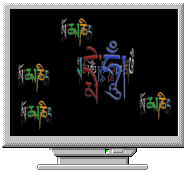 De rondwentelende Tibetaanse tekst van mijn screensaver blijkt een digitaal 'gebedsmolentje' te zijn met de mantra Om Mani Padme Hum:
De rondwentelende Tibetaanse tekst van mijn screensaver blijkt een digitaal 'gebedsmolentje' te zijn met de mantra Om Mani Padme Hum:
'The Mani mantra is the most widely used of all Buddhist mantras, and open to anyone who feels inspired to practice it - it does not require prior initiation by a lama (meditation master).
The six syllables of the mantra, as it is often pronounced by Tibetans - Om Mani Padme Hum - are here written in the Tibetan alphabet:
 Reading from left to right the syllables are:
Reading from left to right the syllables are:
Om (ohm) Ma (mah) Ni (nee) Pad (pahd) Me (may) Hum (hum).
Tibetan Buddhists believe that saying the mantra (prayer) Om Mani Padme Hum out loud or silently to oneself, invokes the powerful benevolent attention and blessings of Chenrezig, the embodiment of compassion. Viewing the written form of the mantra is said to have the same effect - it is often carved into stones, like the one pictured above, and placed where people can see them. Spinning the written form of the mantra around in a Mani wheel (or prayer wheel) is also believed to give the same benefit as saying the mantra.
It is said that all the teachings of the Buddha are contained in this mantra: Om Mani Padme Hum can not really be translated into a simple phrase or sentence.'
Toevoeging mei 2011: De wikipedia vermeldt: 'The middle part of the mantra, maṇipadme, is often interpreted as "jewel in the lotus," Sanskrit maṇí "jewel, gem, cintamani" and the locative of padma "lotus", but according to Donald Lopez it is much more likely that maṇipadme is in fact a vocative, not a locative, addressing a bodhisattva called maṇipadma, "Jewel-Lotus"- an alternate epithet of the bodhisattva Avalokitesvara.' Het Lexicon Boeddhisme geeft: 'het juweel in de lotus', waarbij - als ik het me goed herinner - 'juweel' zou staan voor verlichte geest en 'lotus' voor de leer of weg van Boeddha. [einde toevoeging]
Toevoeging september 2011: Een andere mogelijke betekenis wordt hier vermeld: 'the mantra says, “Om, jewel in the lotus, hum”. The jewel should be assigned to the masculine force and the phallus, whilst the lotus blossom is a symbol of feminine energy. The “jewel in the lotus blossom” thus corresponds to the tantric union, and, since this takes place within a male person, the principle of androgyny' - met ter ondersteuning van deze interpretatie een citaat van de Tibetaanse lama Trijang Rinpoche (1901-1981), een leraar van Tenzin Gyatso, de huidige dalai lama: “... mani indicates the vajra jewel of the father, padma the lotus of the mudra, and the letter hum [indicates] that by joining these two together, at the time of the basis, a child is born and at the time of the [tantric] path, the deities emanate”.
Zie betreffende deze betekenis ook hier en hier. [einde toevoeging]
Overigens is de Tibetaanse "a" op een bepaalde manier present in de tekst: het is het eerste teken - de witte letter - zonder de 'vleugeltjes met rondje' erboven.
Vergelijk deze informatie in de wikipedia: 'Aum (...) is placed at the beginning of most Hindu texts as a sacred exclamation to be uttered at the beginning and end of a reading of the Vedas or previously to any prayer or mantra [vergelijk het christelijke 'amen' - 'het zij zo'; wat je kunt lezen als bevestiging achteraf maar met een beetje fantasie ook als 'scheppingswoord' vooraf ('er zij licht'); en denk aan het Hindoeïstische en Boeddhistische 'svaha']. The Mandukya Upanishad is entirely devoted to the explanation of the syllable. The syllable is taken to consist of three phonemes, a, u and m. (...) As the creation began, the divine, all-encompassing consciousness took the form of the first and original vibration manifesting as sound "OM". Before creation began it was "Shunyakasha", the emptiness or the void. Shunyakasha is more than nothingness, because everything existed in a latent state of potentiality. The vibration of "OM" symbolizes the manifestation of God in form.'
Hierbij moet ik denken aan het indrukwekkende, lang aangehouden, in koor gezongen en op het orgel aangeslagen slotakkoord "Amen" van de Passio van Arvo Pärt. Nog wildere ingeving: Mozart -> Om-art.
En aan klankschalen en de veronderstelde helende werking ervan.
Zie ook mijn blognotities:
Bardo
Praise - pratah smarami
The song which gives the key to perfection
De letter H

Geen opmerkingen:
Een reactie posten